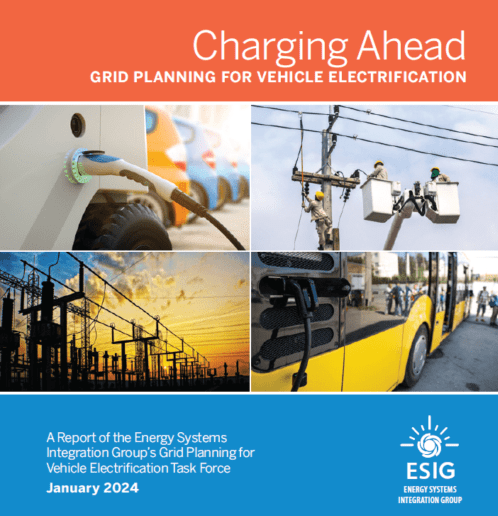New ESIG Report: Opportunities to Evolve Grid Planning for Electric Vehicles

Reston, Va. – The Energy Systems Integration Group (ESIG) has released a new report, Charging Ahead: Grid Planning for Vehicle Electrification, a national-level examination of transportation electrification challenges that impact integrated distribution planning. The report’s primary audiences are utilities, utility regulators and other state decision-makers, EV manufacturers, charge station operators, aggregators, and other technical experts. It explores the challenges of grid planning for electric vehicles; describes roles for existing processes, customer-collaborative processes, and proactive multi-stakeholder processes in enabling vehicle electrification; and outlines four priority actions that can be taken today.
With the accelerated adoption of electric cars, commercial fleets, and trucking, the electric power system—in particular, distribution systems—will be asked to do more, as vehicle charging has the potential to quickly overwhelm grid edge equipment. Public charging sites and vehicle fleet depots can be constructed much faster than other large loads, leaving utilities much less time to upgrade distribution system infrastructure for electric vehicles compared with new loads historically.
“Transportation electrification is one of the biggest disruptors to the grid that we’ve seen over the last several decades,” said Debra Lew, associate director of the Energy Systems Integration Group. “It has the potential to significantly grow load, but more importantly, will impact the distribution system quickly and at locations that the grid may not be prepared for. This report explores considerations for grid planning during a time of high uncertainty and best practices going forward.”
The Energy Systems Integration Group brought together a task force including grid planners, vehicle and charge station manufacturers, charging network operators and aggregators, regulators and state offices, and others to discuss ways that planning practices can evolve to keep pace. Decisions today will strongly affect the preparedness of the grid for vehicle electrification, and this has implications for customers’ EV adoption, vehicle manufacturers’ ability to sell new cars, and public policies intended to reduce emissions and encourage EV adoption. Planners must grapple with the possibility of either over-building the system for load that may not materialize or under-building and potentially leaving the system with insufficient infrastructure to meet EV charging demand.
“EV adoption will change the power system across the country, but often at a highly local level—simultaneously challenging system planners to evaluate impacts across a broad region while targeting upgrades with precision,” said Sean Morash, task force chair. “There are opportunities to manage that challenge through changes in planning to better handle long-, medium-, and near-term EV adoption.”
The report explores challenges related to forecasting EV adoption, characterizing their locational and temporal impacts, identifying mitigations to avoid the largest impacts, and developing roadmaps and grid plans. It concludes with four priority actions that can be taken today: improving forecasting, embracing smart charging, incorporating future-ready equipment, and promoting proactive upgrades.
ESIG is a nonprofit organization that marshals the expertise of the electricity industry’s technical community to support grid transformation and energy systems integration and operation. The report can be downloaded at https://www.esig.energy/grid-planning-for-vehicle-electrification/.


